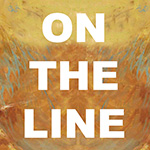Beatriz Mejia-Krumbein
I met Susan for about two years ago, and very soon we got involved in a regular and intense dialogue about our migration journeys as serial migrants, and art. I became very interested in Susan as an artist, and specially in her body of work: On The Line and as director of La Sierra University’s Brandstater Gallery I offered her a solo exhibition. This series of paintings deals with hanging cloth on the line, and is an investigation of concept of the line, bounding, weaving, the thread, continuity, and an exploration of the aesthetic, social and ecological aspects of clotheslines. This exhibition was presented from February 2013 to March 2013.
At the same time that the exhibition was taking place at the La Sierra University’s Brandstater Gallery, Susan was offering a graduate seminar on Anthropology and Art at UCR. The On the Line Exhibit opened a great opportunity as the fieldwork for the seminar, and I became a participant to the seminar to make the possibility to create space for the The Second Look. This Second Look proposed a creative reaction and an intervention to the On The Line Exhibit. The students and some invited local artists were encouraged to interact, manipulate, and make changes in the original exhibition as a creative or ethnographic reaction to Susan’s art.
I regularly attended classroom meetings, participated in the discussions and coordinated the relationship of the seminar with the gallery making the space available for the students. The students had diverse disciplinary backgrounds and not had art background. At the beginning some students felt intimidated by the proposed art intervention, and a lot of dialogue and the opportunity to become familiar with the gallery space and Susan’s art was necessary. The students were able visit the gallery multiple times as group and as individuals, and meet with me to discuss possibilities and development of their proposed pieces. They actively collaborated with me in the curatorial and the installation process of the Second Look. After making the necessary arrangements they installed their own pieces, and prepared text and signage related to their pieces. In one case Susan’s work was used as screen for a video. Her work became activated by the interaction with the video and was transformed and visually and contextually enriched. Other pieces were place in context with her work, or replaced it changing the exhibit original layout. The Second Look art pieces were very diverse in form, and media, including painting, Textiles, installation, photography, Poetry, music, performance, and video. The students attended the reception of the Second Look and each one presented their work.
As an artist I became very interested in creating a performance piece as reaction to the theme titled “Of The Same Fabric”. I presented it to close the reception. I used stories and specific sentences inspired by memories of the practice of hanging cloth on the line in Colombia, Germany, Mexico and USA, and I used the three languages I use in my daily life. I created a dress from a white bed sheet and around eighty small handkerchiefs with the sentence “Of The Same Fabric” printed on them hung from my dress. During the performance the audience was asked to take the handkerchiefs off my dress. At the end of the performance the audience holding hands said together “Of the Same Fabric”
The students addressed ecological, social and gender issues in their work. Family traditions, oral story telling, social-economic layers in the urban society, domestic life, solar energy, etc. The audience response was very positive and lead to lively conversations. This experience was enriching to my art practice not only in respect to the art exploration, and creation, but the collaborative information, and interest in the ethnographic research. I am open to multidisciplinary disciplines, and feel those collaborations expand the possibilities of the ethnographic and art interpretation, and the content and context of the information.
This multi-disciplinary collaboration enriches the collaborators in each discipline and enhances the communication by the use and understanding of the diverse disciplines vocabulary. Also it opens dialogue questioning the roles of the disciplines in the project, the hierarchy and the roles they play, and the integrity of the art as collaborator versus a visual mediator to convey the findings of the research. In my own practice I got enrich by the research methods, and information. The collaborative work is the way to interact in this global world. In my role of artist-communicator my horizon had expanded, feel comfortable dealing with such collaborations and I am looking for to continue searching in this direction
